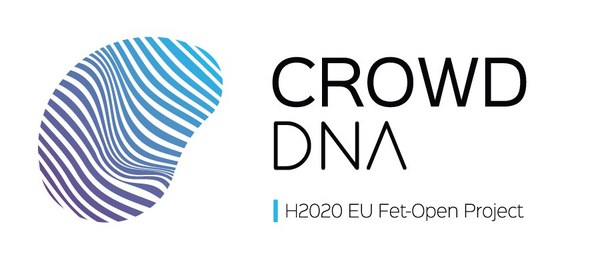
Technologies for Computer Assisted Crowd Management
Facts:
Duration: | November 2020 - October 2024 | |||||
|---|---|---|---|---|---|---|
Funded by: | European Union | |||||
| Call: | FET Open - Novel ideas for radically new technologies | |||||
| Budget: | 3 Million Euro | |||||
Webpage: |
CrowdDNA Team at IAS-7:
Juliane Adrian
Sina Feldmann
Helena Lügering
Anna Sieben
Armin Seyfried
Partner:
- French national research institute for the digital sciences (INRIA)
- University of Leeds (UL)
- Universidad Rey Juan Carlos (URJC)
- Ulm University (ULM)
- Forschungszentrum Jülich GmbH (IAS-7: Civil Safety Research)
- ONHYS
- Crowd Dynamics International
The research projekt CrowdDNA pursues a new approach to assist public space operators in the management of crowds, i.e., mass event organization, heavy pedestrian traffic management, crowd movement analysis and decision support. The main idea behind CrowdDNA is that analysis of some specific macroscopic features of a crowd, such as its apparent motion (that can be easily measured in real mass events) can reveal a valuable information about the internal structure and provide a precise estimate of a crowd state. This vision raises one main scientific challenge, which can be summarized as the need for a deep understanding of the relations between the smallest scales of crowd behaviours (e.g., contact and pushes at the limb scale) and the largest ones up to the entire crowd.
CrowdDNA is a first attempt to combine biomechanical and behavioural simulation in complex scenarios of interactions between many humans. We aim to revolutionize the practices of crowd management to answer the requirements of modern society on safety and comfort at mass events or in crowded transportation facilities.
Crowd DNA Scientific Objectives
CrowdDNA gathers researchers partners from the fields of Physics, Cognitive Science, Computer Science, and Machine Learning together with SMEs in the field of crowd simulation and crowd management, in order to boost crowd science and develop the revolutionary techniques needed to derive the technological solutions sought. The overall objective of CrowdDNA is to design a new generation of crowd motion analysis, as described above. This overall objective raises the 4 following specific objectives:
- Mapping global crowd movements with local physical interactions
- Measure and understand crowd movements at all scales
- Model and simulate physical interactions in crowds
- Compute implementable crowd management actions for safer crowds
Highlights of the IAS-7 contribution to CrowdDNA:

- Execution of large scale experiments on pedestrian dynamics
- Execution of small scale experiments to study the transmission of controlled pulses in small groups.
- Measuring, understanding and linking movements in crowds on different scales (macroscopic to individual body movement)
- Study of social norms and emotions in crowds
Data acquisition with different sensor systems and their analyses, such as
- Extraction of trajectories from video recordings
- 3D motion capture with inertial sensors
- Psycho-physiological sensors for measurement of stress
- Questionnaires on social norms
